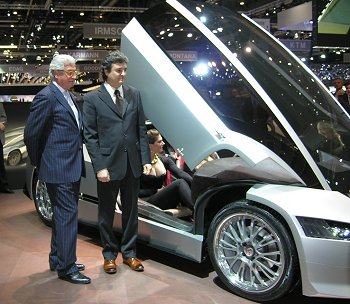
 |
Italdesign Giugiaro celebrated their
fortieth anniversary in Geneva with the
launch of the Quaranta concept car developed
in collaboration with Toyota to showcase
their Hybrid Synergy Drive. |
|
 |
|
|
|
Italdesign Giugiaro celebrated their
fortieth anniversary at the Geneva Motor Show with the
launch of the Quaranta concept car. The concept was
developed in collaboration with Toyota to showcase their
Hybrid Synergy Drive, this time with the innovation of a
central mid-mounted positioning of a hybrid engine on a
super sports car.
For over forty years Italdesign Giugiaro
have been at the forefront in automotive styling,
responsible for a wealth of successful city cars and exotics
alike. This history was illustrated on the large stand space
with historical prototypes, including the Bizzarrini Manta
of 1968, Lancia Medusa of 1980 and Bugatti EB-112 of 1993.
The Quaranta celebrates not only
Giugiaro’s ability in automotive styling, but also
engineering. Italdesign Giugiaro continue to offer packaging
services to leading automotive manufacturers, such as
Volkswagen for their recent Up! concept car.
The Quaranta’s hybrid drivetrain strives
towards providing a car which pollutes less on our roads.
With AWD, the super sports car combines a hybrid engine with
solar energy. The seating layout permits three adults to
travel in comfort, with a central driving position similar
to a Mclaren F1, however also including an extra seating
space for a young child directly behind the driver.
The design of the car uses simple forms,
very much akin to the origami design pushed by Giugiaro back
in the 1970s. In simple terms, it reincarnates the style
language applied to concepts of the past including the 1971
Alfasud Caimano, celebrating a memorable era in Giugiaro’s
history. The sharp edges, however, have also been
reintroduced in order to maximise aerodynamic efficiency. At
the front, two side air inlets positioned above the lighting
clusters perform the delicate function of front stabilisers.
Other aerodynamic features include a spoiler that supports
the lower wing, modelled according to the latest generation
in F1 engineering, which makes up for the absence of the
traditional upper stabiliser.
Access to the cabin is through the huge
forward hinging cockpit, with an almost flat windscreen. A
secondary hinging section at the rear provides access to the
engine compartment and boot. The roof houses a number of
solar panels which power the electric battery located
between the front and rear hinging sections. The solar
panels can generate a power of up to 250 W, which is also
sufficient for the functioning of the cockpit air
conditioning system.
The body of the Quaranta uses a carbon
monocoque frame, clad with aluminium panels and steel
components. The Quaranta is fit with electronic all-wheel
drive, divided in a small electric motor on the
fore-carriage and the thermal engine/electric engine system
located in a central rear position. This particular
structure, which has seen Toyota’s involvement in the
electronic control management, has made it possible to
develop the vehicle on a 2620 mm wheelbase, ideal for a mid-engined
car. The Quaranta features a double fuel-tank, integrated in
the supporting frame, with a total capacity of 60 litres,
giving a mileage of up to 1000 km.
Other innovative features include the
suspension links which have been designed according to F1
cars. These are equipped with a central mono-shock absorber
echoing an idea already presented by Italdesign Giugiaro on
the 2004 Toyota Volta and on the 1997 Alfa Romeo Scighera.
The linkage mechanism of the levers guarantees exceptional
stability in any type of situation, simulating a “multilink”
mechanism. The ground clearance of the Quaranta can also be
raised by up to 230 mm for uneven surfaces.
The Quaranta evolves from the Volta
concept car from 2004. For the Quaranta project, Toyota
provided Italdesign Giugiaro with their latest Hybrid
Synergy Drive system, which consists of a V6 3.3-liter
gasoline engine and two electric motors that operate in
synergy, delivering a high power output which is comparable
to that of an 8-cylinder engine. Despite this, the fuel
consumption and emissions are lower than those of a
4-cylinder engine. In order to improve efficiency and
handling, the intelligent E-Four system automatically
selects rear- or all-wheel drive.
The Quaranta is a showcase of Italdesign
Giugiaro’s engineering, design and prototyping process, with
the concept made completely at Italdesign Giugiaro’s
Moncalieri facilities.
by James
Granger
|